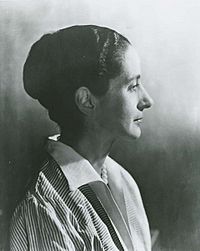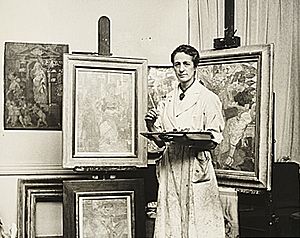Isabel Bishop facts for kids
Quick facts for kids
Isabel Bishop
|
|
|---|---|

Isabel Bishop, 1959 - Photograph from the Archives of American Art, Smithsonian Institution
|
|
| Born | March 3, 1902 Cincinnati, Ohio, United States
|
| Died | February 19, 1988 (aged 85) |
| Nationality | American |
| Education | New York School of Applied Design for Women |
| Known for | Painting, graphic design |
Isabel Bishop (March 3, 1902 – February 19, 1988) was an American painter and printmaker. She is famous for her art showing everyday life in Manhattan, especially around Union Square. Bishop was part of a group of artists called the 'Fourteenth Street School'. Her paintings often featured women and won several awards, including the American Academy of Arts and Letters Award.
Contents
Early Life and Art Education
Isabel Bishop was born in Cincinnati, Ohio, and was the youngest of five children. Her parents were very educated and started a prep school. Even though her family had a long history of wealth, they often faced money problems. This meant they moved around a lot, and Isabel spent her childhood in Detroit, Michigan. Her father, John, was a scholar who studied Greek and Latin. He often became the principal or owner of schools in the new cities they moved to.
Isabel's older siblings were much older than her, so she felt like an only child. Her mother was a strong supporter of women's rights and encouraged her daughters to be independent. When Isabel was 12, she started her art journey. She took a Saturday morning drawing class at the John Wicker Art School in Detroit.
In 1918, at age 15, Isabel finished high school. She then moved to New York City to study illustration at the New York School of Applied Design for Women. After two years, she decided to focus on painting instead. She then attended the Art Students League of New York for four years, until 1924. There, she learned from famous artists like Kenneth Hayes Miller, Guy Pène du Bois, and Robert Henri. She learned a special painting style that was similar to old baroque Flemish painting.
Isabel was a very curious and independent person. At that time, many women were becoming artists, but they were not always taken seriously. Isabel worked hard to prove herself both in her art and in the art world. Her father's cousin, James Bishop Ford, helped pay for all her art studies. Isabel felt lucky, believing that if she had been a boy, her relative might not have supported her so much. She thought he was interested because she was a young woman who was so serious about her art.
Art Career and Style
Isabel Bishop became the only full-time woman teacher at The Art Students League in New York. This was a big step for women in art.
During the 1920s and 1930s, she developed a realistic painting style. She mostly painted women in their daily lives on the streets of Manhattan. Her art was inspired by Peter Paul Rubens and other Dutch and Flemish painters she saw during trips to Europe. She often used a light, yellowish-brown color in her paintings, which was a technique she learned from Rubens.
In 1932, Isabel began showing her work at the new Midtown Galleries. This gallery showed her art throughout her career. In 1934, she married Dr. Harold G. Wolff, a neurologist. She moved to Riverdale, New York, but kept her art studio near Union Square. She used this studio until 1984.
Isabel was fascinated by how people moved and interacted in everyday life. She called this "unfixity"—capturing life and movement on canvas. Her paintings are known for their soft shapes and a unique "pearly" look. She also started making prints, especially using a technique called aquatint.
Her art was shown in the first three Whitney Biennial exhibitions in 1932, 1934, and 1936. She also showed her work in ten other annual exhibitions at the Whitney Museum of American Art. She returned to teach at the Art Students League of New York from 1936 to 1937. In 1940, she became a member of the National Academy of Design. She even had a painting in the art competition at the 1932 Summer Olympics!
In 1938, Isabel painted a mural for a post office in New Lexington, Ohio. It was called Great Men Came from the Hills. This mural showed important people from Perry County, Ohio, admiring their achievements. She included a Revolutionary War soldier, a governor, and other local heroes.
Isabel's later works mostly showed people from the Union Square area of New York. She often painted groups of women interacting. After World War II, she became interested in more abstract scenes of New Yorkers walking or riding the subway. Her art is important because it shows the themes of the "Fourteenth Street School." This was a group of artists, including Reginald Marsh and the Soyer brothers, who worked near Union Square. Her art also contributed to ideas about feminism and the "new woman" in city life.
In the mid-1940s, Isabel was asked to illustrate a new edition of Jane Austen's famous novel, Pride and Prejudice. She created 31 detailed pen-and-ink drawings for the book.
The first big show of Isabel Bishop's art was held in 1974 at the University of Arizona Museum of Art.
Awards and Recognition
Isabel Bishop received many important awards for her art:
- In 1943, she won the American Academy of Arts and Letters Award.
- In 1979, President Jimmy Carter gave her the Outstanding Achievement in the Arts Award.
- In 1987, she received a Gold Medal for Painting from the American Academy of Arts and Letters.
Notable Artworks
Here are some of Isabel Bishop's well-known paintings:
Virgil and Dante in Union Square (1932)
This oil painting is now at the Delaware Art Museum. It hung in Isabel's home for many years and set the theme for her career. As a child, Isabel learned about the story of Virgil and Dante from her mother. The painting shows these two figures in front of Union Square, adding a story to the busy city scene. It helped set the stage for her many paintings and prints of urban life.
Two Girls (1935)
This painting, made with oil and tempera on Masonite, is one of Bishop's most famous works. It is now at the Metropolitan Museum of Art. It took her over a year to finish. Isabel had two friends from the Union Square area pose for the painting. She wanted to capture how the two figures interacted with each other.
Encounter (1940)
In this oil and tempera painting at the St. Louis Art Museum, Isabel Bishop continued to create scenes with multiple figures. It shows a man and a woman interacting on a city street. The woman is shown as confident and direct, which shows Isabel's understanding of how gender roles were changing at the time.
Tidying Up (1941)
Tidying Up is an oil painting on Masonite at the Indianapolis Museum of Art. It shows a young woman who works in an office checking her teeth in a small mirror. This everyday moment shows Isabel's realistic style and her interest in the daily lives of working women. The painting's rough brushstrokes and texture show her interest in old master paintings.
See also
 In Spanish: Isabel Bishop para niños
In Spanish: Isabel Bishop para niños
- Young Woman


